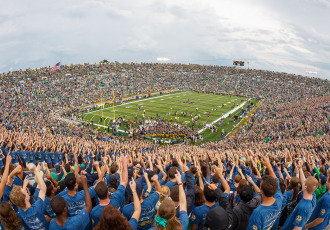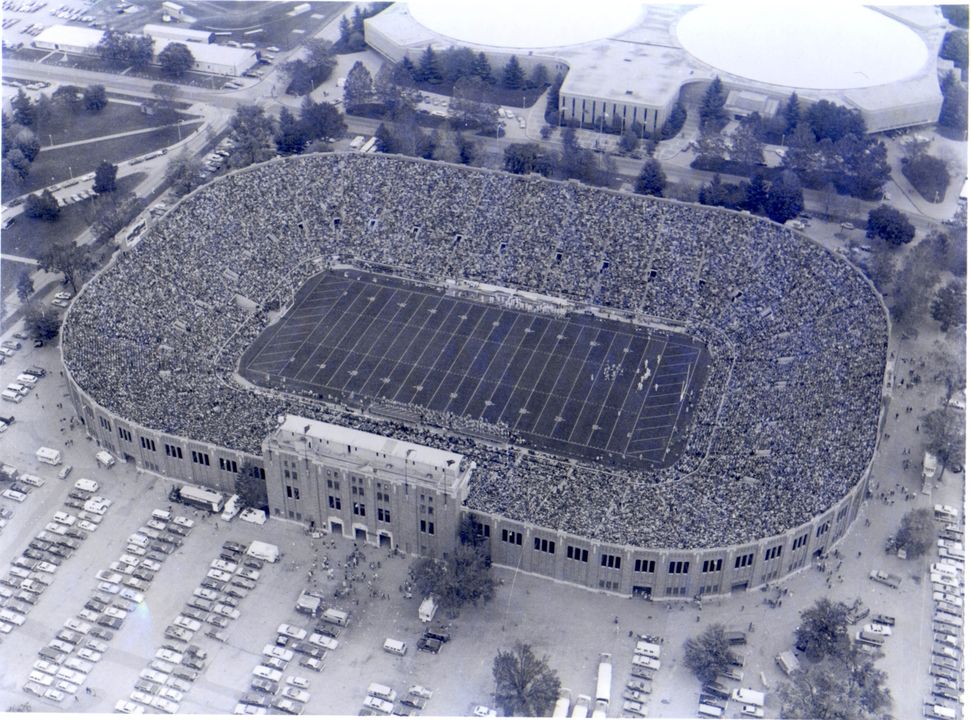Sept. 8, 2016
By John Heisler
The two dates in University of Notre Dame football history qualified as relatively unremarkable in most respects:
–On November 14, 1964-late in Ara Parseghian’s first year as Irish head coach-top-ranked and unbeaten Notre Dame sold out its 34-7 victory over Michigan State at Notre Dame Stadium. Star Irish halfback Nick Eddy ran for 113 yards and soon-to-be Heisman Trophy winner John Huarte threw for 193 more.
The official attendance that afternoon came in at 59,265-back in the days when Notre Dame still used turnstile counts to track spectator numbers. (That policy changed two years later in 1966 when the University began using 59,075 as the consistent sold-out figure.)
Yet that figure was hardly a surprise considering the Spartans routinely played to capacity audiences at Notre Dame Stadium (and before that at Cartier Field).
–Nearly a decade later, on September 26, 1974, Purdue took advantage of two early Irish turnovers at Notre Dame Stadium, built a 24-0 lead before the first period was over and held on to defeat the defending national champion Irish 31-20.
The attendance figure came in at the customary 59,075.
What’s noteworthy about those two contests? They serve as bookends of sorts for Notre Dame’s remarkable string of home sellouts that reaches 250 in a row (and a just-as-amazing 298 of 299) today against Nevada.
The 1964 game marked the first of nearly 50 sellouts in succession at Notre Dame Stadium. The huge success during the Parseghian era seriously began the conversation suggesting Irish home football tickets were going to be hard to find.
The lone blip came in the final home game of the 1973 national championship season. The contest against Air Force, originally set for a Saturday, was moved to Thanksgiving Day at the request of ABC Sports. That meant the game was not included as part of the student season-ticket package-and the end result was that “only” 57,236 fans (about 2,000 short of capacity) showed up to see the Irish thrash the Falcons 48-15.
So that first home game of 1974 against Purdue qualified as the beginning of the current streak that hits the 250 mark this afternoon. In its own way, it counts as one of the more remarkable streaks in Irish athletic history.
To put it in perspective, Nebraska boasts the longest current streak at 347 consecutive sellouts heading into the 2016 campaign. Husker games have been sold out for 54 straight years-with the Nebraska home facility currently listing a capacity of 92,000, including 69,000 season tickets. (It’s worth noting that with more than 25,000 students, the Nebraska student body is more than three times the size of Notre Dame’s undergraduate population.)
The vagaries of what constitutes a sellout or a capacity crowd these days (between facility additions and schools adding new seats) has kept the NCAA from keeping any sort of top 10 list for consecutive sellouts. The NCAA Football Record Book lists only Nebraska as the record-holder in that category, though at least one published report suggests Notre Dame is number two on the list, with Oregon third at 110.
***
The handling of tickets for Irish home football games has undergone various changes through the years-based often on the philosophies of different athletics directors and ticket managers, as well as current supply and demand often based on the success level of that season’s Notre Dame team.
Here’s a quick history lesson in early ticket sales at Notre Dame Stadium:
–In the first season at Notre Dame Stadium in 1930 (Knute Rockne’s last season as head coach), Notre Dame drew more than 40,000 fans for the dedication game against Navy but had three other home games when the attendance did not hit the 15,000 mark. The decade of the 1930s featured only four sold-out home games.
–World War II impacted crowds in the 1940s, yet Notre Dame’s postwar on-field success (the Irish did not lose a game over four straight seasons from 1946 through 1949) helped achieve sellouts in all four 1947 home games and three of four in both 1948 and 1949.
–The 1950s included 35 sellouts, including all five home games in Paul Hornung’s Heisman Trophy season of 1956.
–The Irish struggled on the field during the Joe Kuharich era (1959-62, with Hugh Devore serving as interim coach in ’63), with two of five games sold out in four straight years from 1960 to 1963.
–When Parseghian began in 1964, individual home-game tickets sold for $5.50 each (the first increase in eight years) and qualified as a relative bargain at $25 for a five-game season ticket. In those days the stadium essentially was divided into quarters as far as ticket allocations-the northwest corner for students, the northeast corner for alumni, the southeast corner for the visiting team and the southwest corner for season tickets. Parents of current students were allocated two full sections in the northwest corner.
–In 1953, for example, the season-ticket limit was set at 15,000-then by 1966 it had been elevated to 20,000.
–For many years Irish attendance figures included fans, ushers, police and those seated in the press box.
–The 1966 season marked the first time in Notre Dame history all home game tickets had been sold by August 12. That 1966 campaign also qualified as the first time since 1949 that all home games sold out before the start of the season.
–For many years the advance ticket sales numbers were different than the actual attendance listed-until 1966 when the University opted, with all games essentially sold out in advance, to eliminate the mathematical exercise on Saturdays and simply list the attendance at 59,075.
–With tickets not yet at a premium, many local businesses bought large numbers of seasons tickets in the 1950s and 1960s in support of the program and the University.
Finally, the Parseghian teams turned tickets into hot items on a consistent basis.
Mike Busick started in the Irish ticket office in 1973 and took over as ticket manager in 1975.
“During my years at Notre Dame, the tickets were not yet computer-generated. Ave Maris Press on campus printed index cards in different colors for each home game. Each game required a separate check returned with the right index card, and the colors made the manual sorting process easier,” said Busick, who recalls about 16,000 tickets then being made available to contributing alumni and monogram winners.
“By the late 1970s we began having conversations with the computer people on campus to modernize the process, and my successors combined to take that aspect of it to another level.”
That initiative ultimately resulted in a relationship with Paciolan to provide the software to conduct the alumni ticket lottery. The Notre Dame ticket office continues to work with Paciolan today.
Recalls Busick, “Once a year there was always a call from (University president) Father (Theodore) Hesburgh’s or (University executive vice president) Father (Edmund) Joyce’s office about some dignitary that might attend an upcoming game. And remember that back then there really was no real area in the original press box to entertain University guests. So any ticket manager always had to have four good tickets in his pocket just in case.”
During his years in the job (1975-81), the University also made the decision to charge students for the first time for football tickets. Busick remembers Father Joyce’s concern that any student wanting a football ticket should be able to obtain one.
Current deputy athletics director Jim Fraleigh took over the ticket job in 1997, the same year the University opened the enlarged version of Notre Dame Stadium with about 20,000 additional seats. That project, based primarily on the high ticket demand overall, enabled home games to include around 34,000 tickets in the lottery. At the same time, the season ticket rolls diminished in order to make additional seats available to alumni on a game-by-game basis-understanding that many alumni and fans lived far enough from South Bend to make traveling back and forth to campus for a half-dozen home games per year unrealistic.
The ticket office kept statistics on high-demand games, and Fraleigh recalls that alumni win rates in the 10 percent range spurred the move to add more seats. Even after expansion there seldom has been a shortage of interest. In 2005, as an example, the University announced that it returned $5.2 million based on unfulfilled lottery applications.
Technology has made the business aspect of Notre Dame football tickets much smoother in recent years-including use of the internet to communicate with ticket applicants and the ability to accept credit cards for online transactions.
Notre Dame’s business model for football tickets is almost the opposite of the goal at most major programs. The majority of schools push to sell as many season tickets as possible. At Notre Dame, the intention is to purposefully keep the season ticket list low (currently at 11,000-likely the lowest figure at any Power Five institution) and to make the largest segment of tickets available on a game by game basis to alumni.
In part because of that game plan, Fraleigh marvels at the current sellout streak.
“I think it’s amazing that we’ve sold out all these games all these years considering how few assets we’ve had to offer. We don’t have a video board, and we didn’t really have any premium seating or hospitality. We were selling the opportunity to sit on a wooden bench seat.”
All that changes beginning in 2017 with the completion of the Campus Crossroads Project. For the first time the University will be able to offer premium seating options on the upper levels of the structures currently being completed on the east, west and south sides of Notre Dame Stadium-and a video board will be in operation at the south end. The lower bowl will be reseated to widen all those seats to 18 inches to match the 20,000 in the upper bowl area.
Meanwhile, the sellout streak continues. Current Irish vice president and James E. Rohr director of athletics Jack Swarbrick has made it a priority to keep Notre Dame Stadium current from a technology and experiential standpoint-and he expects those improvements to play a big role in making the in-stadium experience relevant on an ongoing basis. The Irish ranked 15th nationally in attendance in 2015, and Swarbrick and other University officials are confident the size of Notre Dame Stadium makes sense for the decades to come.
Tickets for 2016 Irish home games essentially are all gone-and there’s no shortage of interest when Notre Dame plays on the road. Irish road trips to Virginia and Clemson in 2015 drew record crowds.
The web site MarketWatch in late July listed the top 15 college football games for 2016 in terms of secondary ticket market value-and four Irish games made the chart: The Texas game rated sixth, Michigan State game eighth, Miami game 13th and North Carolina State game 15th.
Recent SeatGeek research into how programs impact ticket prices when they play on the road put Notre Dame number one on the list with the presence of the Irish increasing ticket prices by 98 percent (Michigan and Penn State rated second and third at 68 and 67 percent, respectively).
So, as Notre Dame today puts a bow on its 250th full house in succession, there are literally millions of fans, alumni, administrator and others who have played roles in ensuring that every seat is filled every Saturday in South Bend. It’s safe to say there are dozens of other football programs that wish they could come somewhere near that number.
It’s now 250 and counting.
 The Notre Dame – Nevada game on Sept. 10, 2016, will mark the 250th consecutive sellout at Notre Dame Stadium.
The Notre Dame – Nevada game on Sept. 10, 2016, will mark the 250th consecutive sellout at Notre Dame Stadium.







